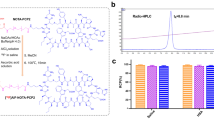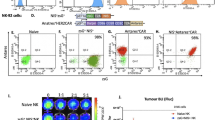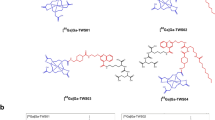Abstract
Purpose
Fludarabine has proven to be of considerable efficacy in the treatment of low-grade lymphomas. We have developed the labeling of this drug with fluorine-18 and evaluated 2-[18F]fludarabine as a novel positron emission tomography (PET) probe for in vivo imaging.
Procedures
Preclinical studies were conducted with 2-[18F]fludarabine, in parallel with 2-deoxy-2-[18F]fluoro-d-glucose ([18F]FDG), in Swiss CD-1 and CB17 severely combined immunodeficient (SCID) mice, both as tumor-free control groups, and SCID mice bearing RL lymphomas.
Results
In Swiss mice, micro-PET studies with 2-[18F]fludarabine showed a distribution restricted to the organs of excretion and the spleen, the latter being less evident in SCID animals. In lymphoma-bearing SCID mice, 2-[18F]fludarabine demonstrated a rapid tumor uptake over the first 20 min which subsequently plateaued and provided an improved contrast than that of [18F]FDG.
Conclusion
This radiotracer merits further evaluation to establish its clinical usefulness to image low-grade lymphoma in humans in future clinical investigations.






Similar content being viewed by others
References
Seam P, Juweid ME, Cheson BD (2007) The role of FDG-PET scans in patients with lymphoma. Blood 110:3507–3516
Schöder H, Moskowitz C (2008) PET imaging for response assessment in lymphoma: potential and limitations. Radiol Clin N Am 46:225–42
Elstrom R, Guan L, Baker G et al (2003) Utility of FDG-PET scanning in lymphoma by WHO classification. Blood 101:3875–3876
Schöder H, Noy A, Gönen M et al (2005) Intensity of 18Fluorodeoxyglucose uptake in positron emission tomography distinguishes between indolent and aggressive non-Hodgkin’s lymphomas. J Clin Oncol 23:4643–4651
Tsukamoto N, Kojima M, Hasegawa M et al (2007) The usefulness of 18F-fluorodeoxyglucose positron emission tomography (18F-FDG-PET) and a comparison of 18F-FDG-PET with 67gallium scintigraphy in the evaluation of lymphoma. Relation to histologic subtypes based on the World Health Organization classification. Cancer 110:652–659
Hoffmann M, Kletter K, Becherer A et al (2003) 18F-Fluorodeoxyglucose positron emission tomography (18F-FDG-PET) for staging and follow-up of marginal zone B-cell lymphoma. Oncology 64:336–340
Gill S, Wolf M, Prince HM et al (2008) [18F]Fluorodeoxyglucose positron emission tomography scanning for staging, response assessment, and disease surveillance in patients with mantle cell lymphoma. Clin Lymphoma Myeloma 8:159–165
Buck AK, Bommer M, Stilgenbauer S, Juweid M, Glatting G et al (2006) Molecular imaging of proliferation in malignant lymphoma. Cancer Res 66:11055–11061
Robak T, Korycka A, Lech-Maranda E, Robak P (2009) Current status of older and new purine nucleoside analogues in the treatment of lymphoproliferative diseases. Molecules 23(14):1183–1226
Keating MJ, O’Brien S, McLaughlin P et al (1996) Clinical experience with fludarabine in hemato-oncology. Hematol Cell Ther 38:83–91
Leporrier M (2004) Role of fludarabine as monotherapy in the treatment of chronic lymphocytic leukemia. Hematol J 5:10–19
Henrich S, Mactier S, Best G et al (2011) Fludarabine nucleoside modulates nuclear “survival and death” proteins in resistant chronic lymphocytic leukemia cells. Nucleosides Nucleotides Nucleic Acids 30:1181–1189
Barrueco JR, Jacobsen DM, Chang CH et al (1987) Proposed mechanism of therapeutic selectivity for 9-β-d-arabinofuranosyl-2-fluoroadenine against murine leukemia based upon lower capacities for transport and phosphorylation in proliferative intestinal epithelium compared to tumor cells. Cancer Res 47:700–706
Grégoire V, Van NT, Stephens LC et al (1994) The role of fludarabine-induced apoptosis and cell cycle synchronization in enhanced murine tumor radiation response in vivo. Cancer Res 54:6201–6209
Plunkett W, Gandhi V, Huang P et al (1993) Fludarabine: pharmacokinetics, mechanisms of action, and rationales for combination therapies. Semin Oncol 20:2–12
Gandhi V, Plunkett W (2002) Cellular and clinical pharmacology of fludarabine. Clin Pharmacokinet 41:93–103
Danhauser L, Plunkett W, Keating M, Cabanillas F (1986) 9-beta-d-Arabinofuranosyl-2-fluoroadenine 5′-monophosphate pharmacokinetics in plasma and tumor cells of patients with relapsed leukemia and lymphoma. Cancer Chemother Pharmacol 18:145–152
Marchand P, Lorilleux C, Gilbert G et al (2010) Efficient radiosynthesis of 2-[18F]fluoroadenosine: a new route to 2-[18F]fluoropurine nucleosides. ACS Med Chem Lett 1:240–243
Guillouet S, Patin D, Tirel O et al. (2013) Fully automated radiosynthesis of 2-[18F]fludarabine for PET imaging of low-grade lymphoma. Mol Imaging Biol (in press)
Dalle S, Dupire S, Brunet-Manquat S et al (2009) In vivo model of follicular lymphoma resistant to rituximab. Clin Cancer Res 15:851–857
Bao Q, Newport D, Chen M et al (2009) Performance evaluation of the Inveon dedicated PET preclinical tomograph based on the NEMA NU-4 standards. J Nucl Med 50:401–408
Müller-Hermelink HK, Montserrat E, Catovsky D et al (2008) Chronic lymphocytic leukaemia/small lymphocytic lymphoma. In: Swerdlow SH, Campo E, Harris NL (eds) WHO classification of tumours of haematopoietic and lymphoid tissues, 4th edn. International Agency for Research on Cancer, Lyon, pp 180–182
Kirschner AS, Ice RD, Beierwaltes WH (1975) Radiation dosimetry of 131I-19-iodocholesterol: the pitfalls of using tissue concentration data, the author’s reply. J Nucl Med 16(3):248–249
Stabin MG, Sparks RB, Crowe E (2005) OLINDA/EXM: the second-generation personal computer software for internal dose assessment in nuclear medicine. J Nucl Med 46:1023–1027
Friedberg JW (2010) PET positive, PET negative, or PET peeve? Blood 115:752–753
Karam M, Novak L, Cyriac J et al (2006) Role of fluorine-18 fluoro-deoxyglucose positron emission tomography scan in the evaluation and follow-up of patients with low-grade lymphomas. Cancer 107:175–183
Keating MJ, O’Brien S, Albitar M et al (2005) Early results of a chemoimmunotherapy regimen of fludarabine, cyclophosphamide, and rituximab as initial therapy for chronic lymphocytic leukemia. J Clin Oncol 23:4079–4088
Byrd JC, Rai K, Peterson BL et al (2005) Addition of rituximab to fludarabine may prolong progression-free survival and overall survival in patients with previously untreated chronic lymphocytic leukemia: an updated retrospective comparative analysis of CALGB 9712 and CALGB 9011. Blood 105:49–53
Eichhorst BF, Busch R, Hopfinger G et al (2006) Fludarabine plus cyclophosphamide versus fludarabine alone in first-line therapy of younger patients with chronic lymphocytic leukemia. Blood 107:885–891
Catovsky D, Richards S, Matutes E et al (2007) Assessment of fludarabine plus cyclophosphamide for patients with chronic lymphocytic leukaemia (the LRF CLL4 trial): a randomised controlled trial. Lancet 370:230–239
Hallek M, Fischer K, Fingerle-Rowson G et al (2010) Addition of rituximab to fludarabine and cyclophosphamide in patients with chronic lymphocytic leukaemia: a randomised, open-label, phase 3 trial. Lancet 376:1164–1174
Solal-Céligny P, Brice P, Brousse N et al (1996) Phase II trial of fludarabine monophosphate as first-line treatment in patients with advanced follicular lymphoma: a multicenter study by the Groupe d’Etude des Lymphomes de l’Adulte. J Clin Oncol 14(2):514–519
Ladel CH, Bamberger U, Püschner H (1991) Histological and cytofluorometric investigations of immunodeficient CB17 SCID/SCID mice. Verh Dtsch Ges Pathol 75:108–113
Deloar HM, Fujiwara T, Shidahara M et al (1998) Estimation of absorbed dose for 2-[F-18]fluoro-2-deoxy-d-glucose using whole-body positron emission tomography and magnetic resonance imaging. Eur J Nucl Med 25:565–57
Acknowledgments
We would like to thank the staff members of the team for their service and support. This work has been in part supported by a grant from the French National Agency for Research called “Investissements d’Avenir” no. ANR-11-LABEX-0018-01, the Commissariat à l’Energie Atomique et aux Energies Alternatives (CEA), and the region Basse Normandie.
Conflicts of Interest
The authors declare that they have no conflict of interest.
Author information
Authors and Affiliations
Corresponding author
Rights and permissions
About this article
Cite this article
Dhilly, M., Guillouet, S., patin, D. et al. 2-[18F]Fludarabine, a Novel Positron Emission Tomography (PET) Tracer for Imaging Lymphoma: a Micro-PET Study in Murine Models. Mol Imaging Biol 16, 118–126 (2014). https://doi.org/10.1007/s11307-013-0659-2
Published:
Issue Date:
DOI: https://doi.org/10.1007/s11307-013-0659-2




